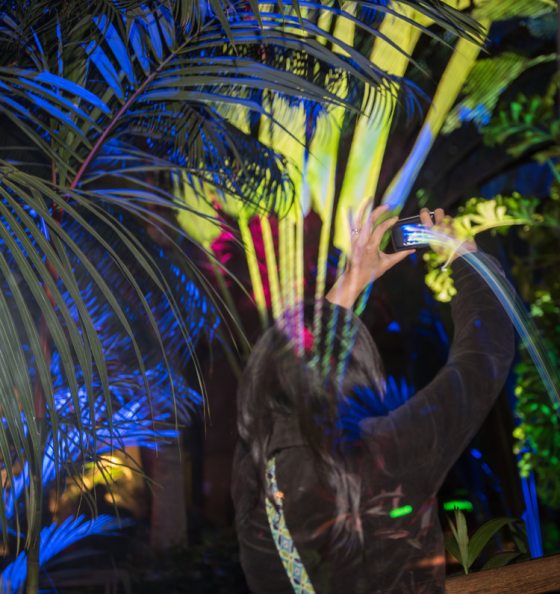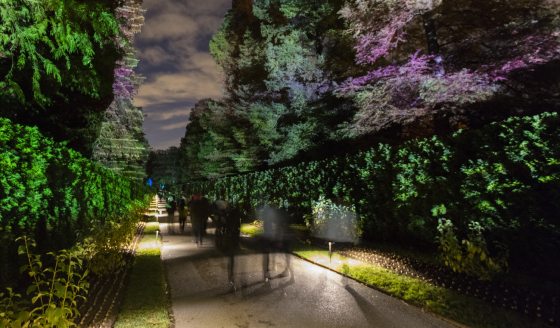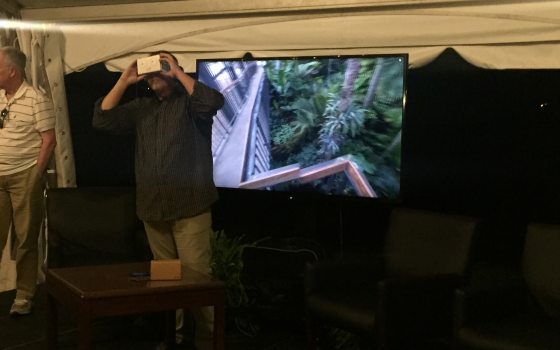The final installment of Nightscape's Artist & Friends on October 7 wrapped up the speaker series with a discussion about the future of virtual experiences. Kevin Ritchie and Mark McCallum of Klip Collective joined founding member Ricardo Rivera to discuss the future of virtual reality and its relationship to fields as varied as art, design, healthcare, and military training; and the place of human agency within art and immersive experiences.
The connection between an outdoor art installation like Nightscape and something as “futuristic” or “sci-fi” as virtual reality (VR) may not be apparent. Rivera describes both as providing immersive experiences—the individual, storytelling journey that art can provide to the viewer. To this end, Rivera sees VR as the future for his work with Klip Collective. “It’s very exciting for us because we create immersive experiences. That’s what Nightscape is. You can see photographs of it and videos, but it’s an experience you have to be here for, in my opinion, to really get the gist of what we’ve done. What’s exciting is that with VR we can transcend that to another medium.”

Experiencing Nightscape at the Large Lake. Photo by Hank Davis.
For an artist like Rivera and a team like Klip Collective, VR provides a logical next step for storytelling because places like Longwood are so engaging. “It’s such a visceral, real experience being here. Yes, it’s great to photograph it and represent it in imagery, but you have to walk through it; you have to see it.” Potentially, VR provides a new method of “seeing” and experiencing not only traditional works of art, but even practical daily experiences.
Most people are well-versed with traditional modes of visually recording an environment. A typical camera records an image, and the viewer sees that image and nothing else beyond its frame. VR cameras record the environment in a 360° format. When these images are played back through VR equipment, the viewer can look around and absorb all or part of the surrounding “environment.” Viewers are not forced to look in one direction or to stay within the visual boundaries of another person’s choice. In this way, VR mimics how we take in and move through everyday life: at any given moment, we choose what we want to see and move in directions where we want to go.
Currently, the cameras and equipment used in the making and viewing of VR content are not common consumer products. However, the panelists pointed out that this is quickly changing. VR cameras and headsets are becoming more widely available and affordable. Rivera predicts that within two to three years most people will own or have access to VR equipment, such as the increasingly popular Samsung Gear VR or the recently released VR game system from PlayStation. Even well-known international film festivals such as Cannes and Sundance have been featuring VR films alongside traditional movie formats. Anything that can be photographed, filmed, or projected can be tailored to the VR format, but not everyone feels ready to explore this newer format even in artistic media like film and movies.
In an interview at the 2016 Cannes Film Festival, Academy Award-winning director Steven Spielberg noted that VR challenges the very foundation of the movie director’s role: “I think we’re moving into a dangerous medium with virtual reality. The only reason I say it’s dangerous is because it gives the viewer a lot of latitude not to take direction from the storytellers but make their own choices of where to look.” (It should be noted that since Spielberg made these comments in May 2016, he has signed on to a virtual reality project.)

The Palm House. Photo by Hank Davis.
However, Rivera argued that this element of agency—a participant’s ability to make choices within the immersive experience—presents a value that some artists cannot resist and will certainly provide an entirely new way of telling stories in the coming years, especially as this technology becomes increasingly democratic. “Even with passive VR you’re still interacting because you can look around,” says Rivera. “You’re engaging in the space by looking at what you want to look at, not what the filmmaker is telling you to look at.”
One of the best things about the increasing ubiquity of VR-related art is its potential to ameliorate stressful situations. Rivera and Klip Collective are currently exploring VR use in hospitals and medical settings—these places tend to be cold, sterile, and anxiety-producing to many people. If VR becomes more common, it can help patients to virtually transport themselves to less stressful environments while still receiving the needed care, potentially helping patients to respond to their treatments more effectively.
Similarly, the military has started to use VR to train soldiers for dangerous circumstances without actual exposure to harm. There are even programs to expose soldiers to post-traumatic stress disorder (PTSD) triggers to help them work through trauma. Businesses and corporations have expressed interest in using VR for job training and product testing and development. Perhaps not all of these uses are glamorous, but the full range of what VR could revolutionize remains to be seen.
The end of this panel session wrapped up with Rivera, McCallum, and Ritchie offering the audience two different VR experiences to try. “We can talk about this all day, but until you actually immerse yourself in it, you don’t really get what it’s all about,” encouraged Rivera, and many of the audience members lined up to see the footage the team had brought with them. While Nightscape itself is not formally considered “virtual reality,” it has served as an immersive experience for thousands of visitors to Longwood Gardens over the course of two summers. While the artists, designers, producers, and musicians behind Nightscape made countless choices to design the final product, the entire point of the project rests on allowing each viewer to make his or her own choices while walking through the Gardens.
This session on virtual reality was a fitting capstone to the Artist & Friends speaker series, reminding us of how technology is pushing the bounds of art and the human experience.

Flower Garden Drive. Photo by Daniel Traub.


